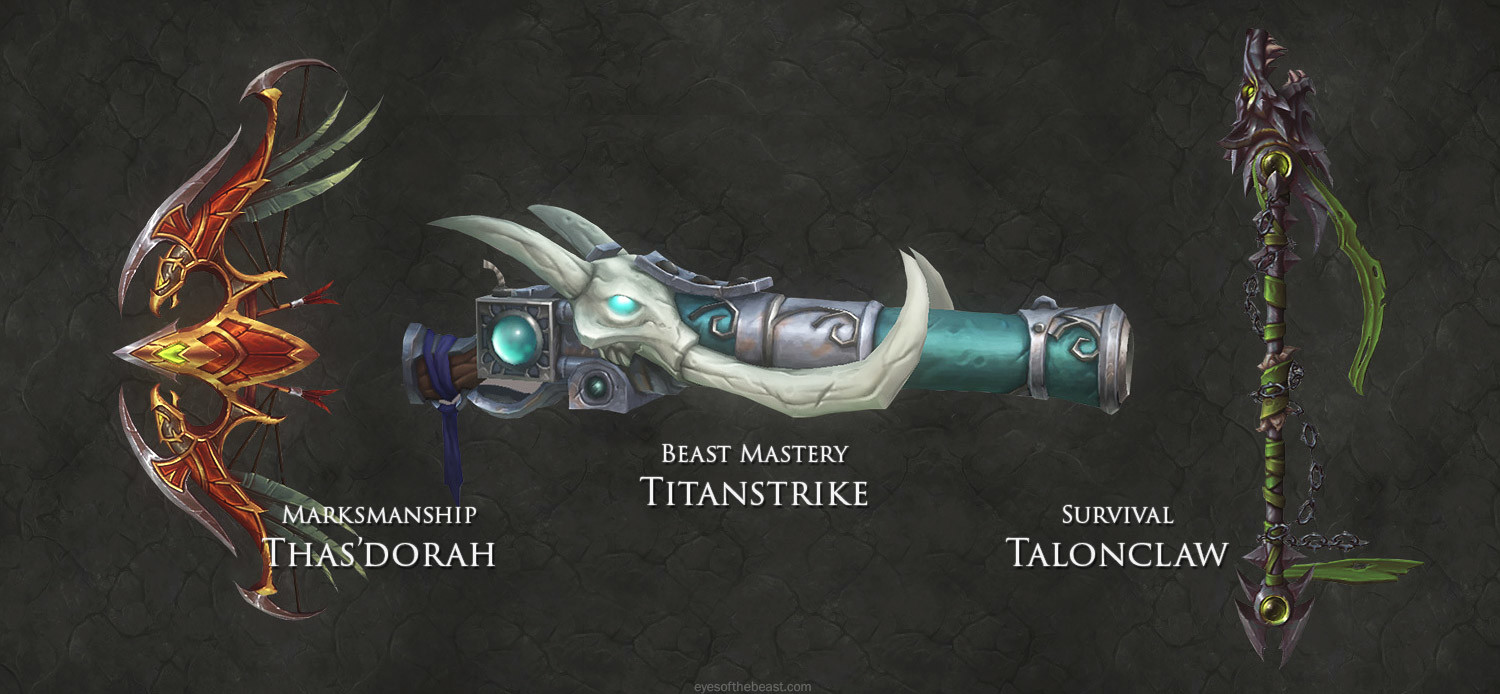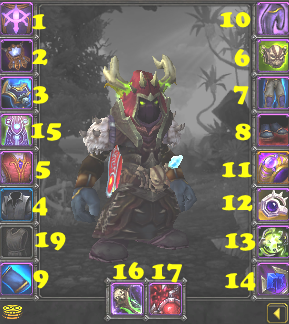Wow Macro Belt Slot Number
- 'Hands' redirects here. For the hozen, see Hands (hozen).
However, using the numeric equipment slot identifiers eliminates the need to manually modify macros after upgrading a particular item. These slot designations are particularly handy for engineers whose Tinker enhancements and Engineering-only items add and/or posses an 'on use' ability for items in the Back, Belt, Foot and Head slot that would. WoW item slot for macro. Here is a list of the item slot numbers for your character: Head = 1 Neck = 2 Shoulders = 3 Body = 4 (shirt) Chest = 5 Waist = 6 Legs = 7 Feet = 8 Wrist = 9 Hand = 10 Finger1 = 11 Finger2 = 12 Trinket1 = 13 Trinket2 = 14 Back = 15 Mainhand = 16 Offhand = 17 Tabard = 19. Here is a graphical explaination of your character. To make is easier to work out which slot number equates to which equipment slot on your character, Macro Toolkit includes a dropdown that list all available slots by name, and inserts the appropriate number into your macro. Backup / Restore / Clear All. Macros can be backed up to your saved variables file and restored later.
- 1Armor
- 2Non-armor
- 3Weapons
- 4Decorative
- 5Other
- 6Removed

There are 18 equipment slots on a character, as well as 4 bag slots above the Micro Menu and a mount equipment slot in the Mount Journal. The combination of equipment slot and item type is often the first categorization of items used.
Armor
The eight armor slots may have one of four types of armor: cloth, leather, mail, and plate. Each class may equip only certain types of armor.
Head
- Equipment names
- helm, helmet, mask, lens, monocle, cap, headpiece, crown, circlet, shroud, cowl, hood, headband, goggles, coif, headdress, chapeau, barbute
- Upgrades
- Meta gems, Gems
Shoulders
- Equipment names
- amice, spaulders, pads, pauldrons, mantle, monnions, epaulets, shoulder, shoulderpads, shoulderguards
- Upgrades
- Shoulders enchants, Gems, Inscriptions (inscribers only)
Chest
- Equipment names
- robes, vest, tunic, armor, wraps, harness, hauberk, jerkin, chain, breastplate, blouse, chestpiece
- Upgrades
- Chest enchants and armor kits, Gems

Wrist
- Equipment names
- bindings, armguards, cuffs, bracers, vambraces, wristguards, bracelets
- Upgrades
- Wrist enchants, Gems, Fur Lining (Leatherworkers only), [Socket Bracer] (Blacksmiths only)
Hands
- Equipment names
- gloves, gauntlets, mitts, mittens
- Upgrades
- Hands enchants and armor kits, Gems, Tinkers (Engineers only), [Socket Gloves] (Blacksmiths only)
Waist
- Equipment names
- belt, girdle, sash, cinch, cord
- Upgrades
- Belt Buckles, Gems, Tinkers (Engineers only)
Legs
- 'Legs' redirects here. For the companion, see [Legs].

- Equipment names
- chausses, trousers, breeches, leggings, kilt, dungarees, loincloth, woollies, pants, britches
- Upgrades
- Legs armor kits and spellthreads, Gems
Feet
- Equipment names
- boots, walkers, greaves, footwraps, sabatons, slippers, shoes, stompers, footpads
- Upgrades
- Feet enchants and armor kits, Gems
Non-armor
Non-armor gear only has one type, so there will be nothing in the 'type' spot in item tooltips.
Neck
- Equipment names
- amulet, lei, talisman, medallion, necklace, charm, choker, chain, pendant, collar.
- Upgrades
- Gems
Back
- Equipment names
- cape, blanket, cloak, drape, mantle
- Upgrades
- Back enchants, Gems, Embroideries (Tailors only), Tinkers (Engineers only)
Finger
- Equipment names
- ring, band, signet, seal, loop, circle.
- Upgrades
- Enchantments (Enchanters only), Gems
Two finger slots are available
Trinket
- Upgrades
- Gems (Jewelcrafters only)
Two trinket slots are available
Weapons
Main-Hand (One-Hand/Two-Hand)
One-hand items,
Two-hand items categories
- Weapon types
- Axe, Bow, Crossbow, Dagger, Fist weapon, Gun, Mace, Polearm, Staff, Sword, Wand, Fishing Pole
- Upgrades
- Weapon enchants, Counterweights, Weapon Chains, Fishing line (fishing pole only)
The Main Hand slot can hold main hand, one-handed or two-handed weapons. If a two-handed weapon is equipped, the off-hand slot must be empty unless the character is a warrior with the [Titan's Grip] talent.

Off-Hand (One-Hand/Two-Hand)
- Weapon types
- Axe, Dagger, Held In Off-hand, Fist weapon, Mace, Shield, Sword
- Upgrades
- Enchantments, Counterweights, Weapon Chains, Shield Spike
The Off Hand slot can hold off hand or one-handed weapons (Dual wielding classes only), shields (warrior, paladin and shaman only) or Held In Off-hand frill items. If a two-handed weapon is equipped in the main hand slot, this slot must be empty unless the character is a Fury warrior with [Titan's Grip].
Decorative
Decorative items only have one type, so there will be nothing in the 'type' spot in item tooltips. Decorative items have no stats and cannot be upgraded.
Tabard
Shirt
Wow Classic Slot Numbers
Other
Bag
Removed
Ammo
Ranged or Relic
Equipment slots in macros
When creating macros based on 'click to use' items (especially trinkets), the common practice is to enter the actual item name. However, using the numeric equipment slot identifiers eliminates the need to manually modify macros after upgrading a particular item.
These slot designations are particularly handy for engineers whose Tinker enhancements and Engineering-only items add and/or posses an 'on use' ability for items in the Back, Belt, Foot and Head slot that would not normally posses such capability for non-engineers.
Here are is a complete list of each equipment slot and its numeric designation for macro purposes
Wow Macro Guide
| Slot | Number |
|---|---|
| Head | 1 |
| Neck | 2 |
| Shoulder | 3 |
| Shirt | 4 |
| Chest | 5 |
| Belt | 6 |
| Legs | 7 |
| Feet | 8 |
| Wrist | 9 |
| Gloves | 10 |
| Finger 1 (Top) | 11 |
| Finger 2 (Bottom) | 12 |
| Trinket 1 (Top) | 13 |
| Trinket 2 (Bottom) | 14 |
| Back | 15 |
| Main Hand | 16 |
| Off Hand | 17 |
| Tabard | 19 |
Patch changes
- Patch 5.0.4 (2012-08-28): Range/Relic slots are being removed from all classes. Range weapons (bows, guns, wands) will use the main hand slot.
- Patch 4.0.1 (2010-10-12): The ammo mechanic was removed from the game, and the ammo slot was removed along with changing ammo items to gray items.
| ||||||||||||||||||||
Home > Macro Basics
|